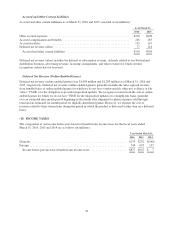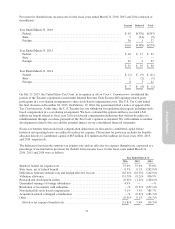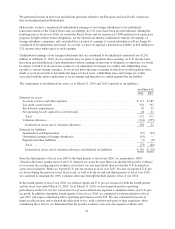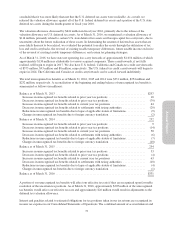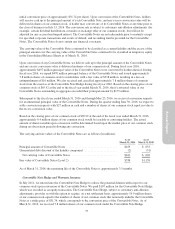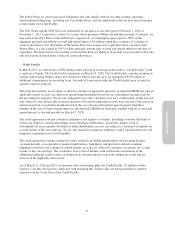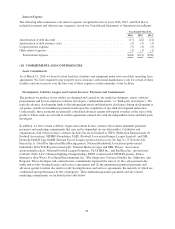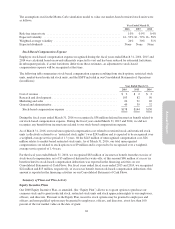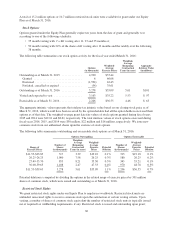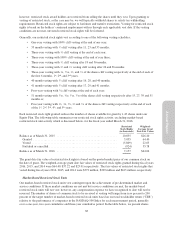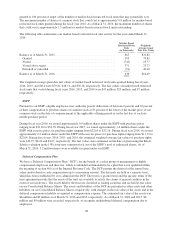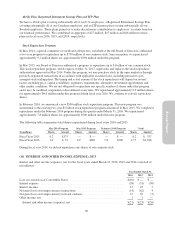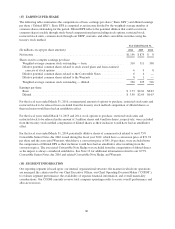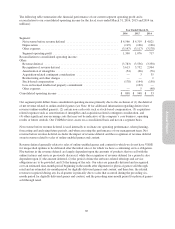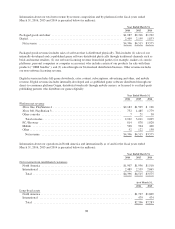Electronic Arts 2016 Annual Report Download - page 166
Download and view the complete annual report
Please find page 166 of the 2016 Electronic Arts annual report below. You can navigate through the pages in the report by either clicking on the pages listed below, or by using the keyword search tool below to find specific information within the annual report.
We are also subject to claims and litigation arising in the ordinary course of business. We do not believe that any
liability from any reasonably foreseeable disposition of such claims and litigation, individually or in the
aggregate, would have a material adverse effect on our Consolidated Financial Statements.
(14) PREFERRED STOCK
As of March 31, 2016 and 2015, we had 10,000,000 shares of preferred stock authorized but unissued. The rights,
preferences, and restrictions of the preferred stock may be designated by our Board of Directors without further
action by our stockholders.
(15) STOCK-BASED COMPENSATION AND EMPLOYEE BENEFIT PLANS
Valuation Assumptions
We estimate the fair value of stock-based awards on the date of grant. We recognize compensation costs for
stock-based awards to employees based on the grant-date fair value using a straight-line approach over the
service period for which such awards are expected to vest.
The determination of the fair value of market-based restricted stock units, stock options and ESPP is affected by
assumptions regarding subjective and complex variables. Generally, our assumptions are based on historical
information and judgment is required to determine if historical trends may be indicators of future outcomes. We
determine the fair value of our stock-based awards as follows:
•Restricted Stock Units. The fair value of restricted stock units is determined based on the quoted
market price of our common stock on the date of grant.
•Market-Based Restricted Stock Units. Market-based restricted stock units consist of grants of
performance-based restricted stock units to certain members of executive management that vest
contingent upon the achievement of pre-determined market and service conditions (referred to herein
as “market-based restricted stock units”). The fair value of our market-based restricted stock units is
determined using a Monte-Carlo simulation model. Key assumptions for the Monte-Carlo simulation
model are the risk-free interest rate, expected volatility, expected dividends and correlation coefficient.
•Stock Options and Employee Stock Purchase Plan. The fair value of stock options and stock purchase
rights granted pursuant to our equity incentive plans and our 2000 Employee Stock Purchase Plan, as
amended (“ESPP”), respectively, is determined using the Black-Scholes valuation model based on the
multiple-award valuation method. Key assumptions of the Black-Scholes valuation model are the risk-
free interest rate, expected volatility, expected term and expected dividends. The risk-free interest rate
is based on U.S. Treasury yields in effect at the time of grant for the expected term of the option.
Expected volatility is based on a combination of historical stock price volatility and implied volatility
of publicly-traded options on our common stock. Expected term is determined based on historical
exercise behavior, post-vesting termination patterns, options outstanding and future expected exercise
behavior.
There were an insignificant number of stock options granted during fiscal year 2016.
The assumptions used in the Black-Scholes valuation model to value our stock option grants and ESPP were as
follows:
Stock Option Grants ESPP
Year Ended March 31, Year Ended March 31,
2015 2014 2016 2015 2014
Risk-free interest rate .............. 1.1-1.9% 1.6% 0.3 - 0.6% 0.04 - 0.2% 0.1%
Expected volatility ................ 36-40% 37-42% 32-36% 30-35% 36-38%
Weighted-average volatility ......... 38% 37% 33% 34% 38%
Expected term .................... 4.5years 4.5 years 6 - 12 months 6 - 12 months 6 - 12 months
Expected dividends ................ None None None None None
80


